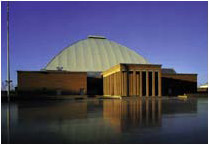The Palazzo "Mauro De André" was built in 1989-90 to architect Carlo Maria Sadich’s design on the initiative of the Ferruzzi Group who wished to dedicate it to the memory of a collaborator who had died prematurely, brother of the singer-songwriter Fabrizio De Andrè.
The inauguration took place in October 1990.
The complex, which at last gave Ravenna a suitable space for great sporting, business and cultural events, stands on a rectangular area of about 12 hectares near the industrial estates and the port, but at the same time close to the town centre. The access propylaea in brickwork along the west side overlook a great open space that extends to the opposite side where the massive reddish "Grande ferro R" stands out. This work of Alberto Burri consists of two stylised metal hands joined to form the image of an overturned keel, almost a celebration of seafaring Ravenna, place of welcome and meeting point for peoples and different civilisations. To the side of the propylaea the fountains in travertine, designed by Ettore Sordini, also function as reserve tanks for fire-fighting water.
The great building occupies the area to the north, the south part being set aside for open air events.
Access to the building is by way of the so-called Danteum, a sort of peripteral temple of 260 square metres formed by a forest of pillars and columns numbering one hundred, like the cantos of the Divine Comedy. In particular, the brickwork pillars of the external rows are flanked internally by five columns in iron, thirteen in Carrara marble and nine in glass, an image of the three parts of Dante’s work.
The Palazzo is quadrangular plan with a continuous brickwork facing enlivened at the front, between the two projecting avant-corps at the sides, by a mosaic decoration designed by Elisa Montessori and made by Luciana Notturni. The great white cupola stands out above: 54 metres per side, the double layer reticular metal structure is covered by a 5307 square metre translucent membrane in fibreglass spread with P.T.F.E. (Teflon). The cupola terminates in a square element – about 8 metres per side – which can be opened electrically for interior ventilation.
The great interior can accommodate about 3800 people and its spatial features can be radically altered to suit various requirements (sports events, trade fairs, concerts): by means of a system of tracks the great mobile tiers of seats can be shifted outside either to make room in the indoor area or supply seating for outdoor shows at the back.
The building, which as early as 1990 was the venue for a concert conducted by Valerij Gergiev and featuring Mstislav Rostropovich and Uto Ughi, has been regularly used for some of the most important Ravenna Festival artistic events. One need only mention Verdi’s Requiem Mass and Nabucco conducted by Muti in 1994 and 1995, the concerts of the Wiener Philharmoniker conducted by Ozawa (1994), Muti (1998), the Philharmonia Orchestra and the Filarmonica della Scala conducted by Muti (1995-1998) and Sawallisch (1994), the Philadelphia Orchestra conducted by Muti (1993), the Orchestra del Maggio Fiorentino conducted by Mehta (1993), the London Symphony Orchestra conducted by Boulez (1993), the Schleswig-Holstein Musik Festivalorchester conducted by Solti (1993), the Berliner Philharmoniker conducted by Abbado (1992), the Bayerischen Rundfunk Orchestra conducted by Maazel (1995, 1998), the Bayerisches Staatsorchester conducted by Kleiber (1997), the Philharmonia Orchestra conducted by Chung (1994), the Orchestra Nazionale della RAI conducted by Sawallisch (1996) and Rostropovich (1998), the Ensemble Intercontemporain conducted by Boulez (1996), the Orchestra dell’Accademia di S.Cecilia conducted by Chung (1997), the Staatskapelle of Dresden conducted by Sinopoli (1994, 1997) and the Marijnskij Orchestra of St. Petersburg (1995, 1997).

















































